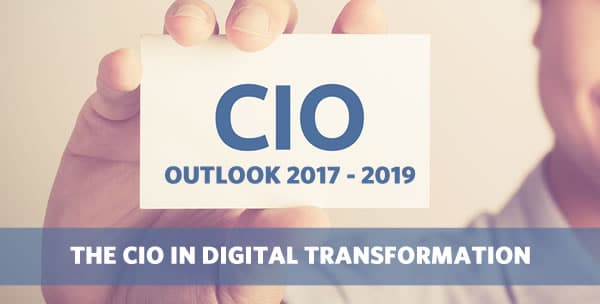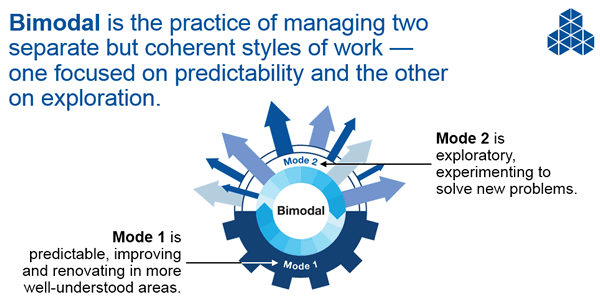To say that CIOs didn’t understand the business in the past would be a big exaggeration. However, we can’t ignore that many CIOs weren’t involved in the business enough and looked too much at their role in “making things run”.
As digital transformation became essential and each business really became an IT business, with among others LOB executives taking decisions in areas that would normally belong to IT, this all changed.

From two IT models to the omnipresence of IT
With the call for a bi-modal it, companies such as Gartner since several years advice to distinguish between that dimension of making sure that IT runs (the systems of record perspective, daily operations, traditional IT tasks) and a dimension of digital transformation, agility, innovation and business (the systems of engagement and systems of insight perspective). Cloud computing obviously plays an important role in both models.
As you know not everyone is equally happy with that bimodal approach as in more than one way it also implies two speeds and a sort of a separation in a holistic digital business reality where we try to do the opposite: integrate and connect. But that’s another debate which Gartner and many others have addressed several times. IT is omnipresent and has so many facets that an integrated view is inevitable, even if de facto, various IT tasks require different approaches.
What is clear is that CIOs have been – and are – facing big challenges in a reality where more IT buying decisions are made by ‘the business’ (de facto mainly marketing).
It’s also a reality in which they were asked to focus more on the business goals (and often succeeded, getting a more important role in the organization and around the boardroom table) and a reality in which they were challenged by phenomena such as consumerization, to name just an important one.
The role of the CIO as a digital business expert in transformation
The role of the CIO is definitely changing. How exactly it is changing depends on the organization but we know that in general the CIO is asked to become an enabler and a strategic builder of bridges in a digital transformation economy.
We covered these evolutions several times before as in this piece on the ‘digital CIO’. And we all know that it is happening.
The role of the CIO and of IT for that matter isn’t of course becoming less important. It is shifting. We see new roles popping up for years now and many CIOs now carry another job title but the essence remains.
And that essence is that technology and IT are profoundly impacting all areas of business and society. As IDC said in its FutureScape 2017 IT predictions: all companies are bound to become digital natives and, just as CIOs are challenged to become digital business experts, business executives are challenged to become far more than just ‘digital savvy’, which will even be felt all the way to the profile and experience of future CEOs.

IT becomes more business-critical in a digital economy
IT, in the broadest possible sense, is business-critical. With data as a key business asset how else could it be? All aspects regarding data and information are essential for the business.
It’s clear that we need IT, data experts and information managers for that. If (big) data and the insights we derive from it is business, then information technology and information management are important for the business.
Security is the backbone of digital business but often overlooked in digital transformation.
The role of the CIO (and the CISO if there is one) is key here as well.
It’s about data, networks, users, education, all important elements. Without proper security no digital business. IT has a key role here. Just look at the security challenges in the Internet of Things or how security is often overlooked in digital transformation.
Networks, cloud platforms, IoT platforms, any networks and platforms whatsoever, are crucial for digital business.
If there is no connectivity, no storage, no communication, no network, no analysis, then there is no digital business.
Who is taking care of that? Your network is not ran, secured, optimized and accelerated for applications by the business, is it?
We could go on with more examples such as enterprise IT infrastructure, mobile and mobility, governance and risk, you name it.
Why you need a CIO role – regardless of the exact title
The fact is that, given the importance of technology and IT in a digital transformation reality, which is only about to accelerate, CIOs and IT are needed a lot.
Yes, they become more involved in ecosystems whereby they focus on outcomes, business goals and visibility across a complex ecosystem with all sorts of technology partners. And, yes, they work with the business.
However, regardless of their exact title, you should not overlook them as is often the case for the sake of ‘agility’ or saving a bit of money. If there are issues in this regard they need to be solved, not overlooked. You don’t deploy any project whatsoever without security from step one. You don’t buy a solution without tapping into the know-how of your IT execs. Because if you do, you’re bound to come across crucial errors and digital transformation failure somewhere along the road.
Of course this does require that the CIO adapts as well. They need to show they are able to keep up with the pace of digital transformation. And they need to be enabled to do so as well. This requires that no part of IT is looked at as a cost center which leadership rather wouldn’t have but that IT and the CIO are seen as the protectors and creators of business value with a clear CEO mandate.
The CIO as a holistic thinking and acting enabler, orchestrator, innovator and revenue creator
CIOs are becoming orchestrators and builders of connections, ecosystems and tangible value.
- They need to make IT solutions easy, scalable, agile, visible and transparent for the organization and stakeholder, without the complexity, which they have to manage (partners, vendors, integrators, technologies, you name it), showing to the business.
- They need to make sure that user adoption drives applications instead of IT deciding and users being forced to adapt instead of adopt.
- They need to co-drive the digital transformation shift towards all parts of the business.
- They need to have an organization that educates, informs, learns and helps in cultural shifts.
- They need to put business and stakeholders first: from customers and users to partners and leadership.
- They need to make sure that the resources and skills are present with an important role in building the talent pools their business will need to succeed.
- They need to point out the key aspects that the business needs to take into account in order to succeed their digital transformations.
- They need to focus on innovation as a core part of their duties as they know the technological aspects better than anyone else and collaborate to innovate.
- They need to be the orchestrators of cloud ecosystems in a multi-cloud and increasingly hybrid cloud reality and of other technological ecosystems which all need to be connected with a focus on speed, agility and the business.
Or, to summarize it all: they need to be holistic thinking and acting leaders with the same skills as other leaders who transform their organizations and with a focus on collaboration, innovation, optimization, change and building a fast and agile IT team that is accessible and can help create value.
Role of the CIO outlook: value creation and the CIO agenda 2017 – 2019
This creation of value will drive the further evolution of the CIO role and has many facets, from enabling speed to creating new revenue streams.

In its “IDC FutureScape: Worldwide CIO Agenda 2017 Predictions“, research firm IDC, advices CIOs to look at the evolutions and challenges facing them through the lens of digital transformation and the company’s digital transformation maturity approach.
Here are some of the predictions IDC shares in the announcement of its CIO Agenda 2017 outlook (with a few about the development of new skillsets and IT services which prepare the organization for later evolutions):
- By 2019, 40 percent of IT projects will create new digital services and revenue streams that monetize data.
- By 2019, 75 percent of CIOs will recognize the limitations of traditional IT and embrace a leadership approach that embodies a virtuous cycle of innovation.
- 45 percent of CIOs will shift primary focus from physical to digital and move away from BPM and optimization by 2018 to deliver scale, predictability, and speed.
And then there is this one in the context of bimodal IT (IDC has been attacking bimodal IT for a few years now, the battle of the analysts): “by 2019, 80% of bimodal IT organizations will accumulate a crippling technical debt resulting in spiraling complexity, costs, and lost credibility”.
More data, predictions and context in the press release.
Quotes and data mentioned in this article come from the announcement of IDC’s Worldwide CIO Agenda 2017 Predictions. Top image: Shutterstock – Copyright: Shayneppl – All other images are the property of their respective mentioned owners.

